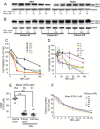Inhibition of IRE1α-driven pro-survival pathways is a promising therapeutic application in acute myeloid leukemia
- PMID: 26934650
- PMCID: PMC4951325
- DOI: 10.18632/oncotarget.7702
Inhibition of IRE1α-driven pro-survival pathways is a promising therapeutic application in acute myeloid leukemia
Erratum in
-
Correction: Inhibition of IRE1α-driven pro-survival pathways is a promising therapeutic application in acute myeloid leukemia.Oncotarget. 2017 Sep 8;8(38):64651. doi: 10.18632/oncotarget.20707. eCollection 2017 Sep 8. Oncotarget. 2017. PMID: 28969101 Free PMC article.
Abstract
Survival of cancer cells relies on the unfolded protein response (UPR) to resist stress triggered by the accumulation of misfolded proteins within the endoplasmic reticulum (ER). The IRE1α-XBP1 pathway, a key branch of the UPR, is activated in many cancers. Here, we show that the expression of both mature and spliced forms of XBP1 (XBP1s) is up-regulated in acute myeloid leukemia (AML) cell lines and AML patient samples. IRE1α RNase inhibitors [MKC-3946, 2-hydroxy-1-naphthaldehyde (HNA), STF-083010 and toyocamycin] blocked XBP1 mRNA splicing and exhibited cytotoxicity against AML cells. IRE1α inhibition induced caspase-dependent apoptosis and G1 cell cycle arrest at least partially by regulation of Bcl-2 family proteins, G1 phase controlling proteins (p21cip1, p27kip1 and cyclin D1), as well as chaperone proteins. Xbp1 deleted murine bone marrow cells were resistant to growth inhibition by IRE1α inhibitors. Combination of HNA with either bortezomib or AS2O3 was synergistic in AML cytotoxicity associated with induction of p-JNK and reduction of p-PI3K and p-MAPK. Inhibition of IRE1α RNase activity increased expression of many miRs in AML cells including miR-34a. Inhibition of miR-34a conferred cellular resistance to HNA. Our results strongly suggest that targeting IRE1α driven pro-survival pathways represent an exciting therapeutic approach for the treatment of AML.
Keywords: ER stress; IRE1; XBP1; micro RNA; unfolded protein response.
Conflict of interest statement
The authors declare no conflicts of interest
Figures







Similar articles
-
Opposite Roles of RNase and Kinase Activities of Inositol-Requiring Enzyme 1 (IRE1) on HSV-1 Replication.Viruses. 2017 Aug 23;9(9):235. doi: 10.3390/v9090235. Viruses. 2017. PMID: 28832521 Free PMC article.
-
ER stress and distinct outputs of the IRE1α RNase control proliferation and senescence in response to oncogenic Ras.Proc Natl Acad Sci U S A. 2017 Sep 12;114(37):9900-9905. doi: 10.1073/pnas.1701757114. Epub 2017 Aug 28. Proc Natl Acad Sci U S A. 2017. PMID: 28847931 Free PMC article.
-
Blockade of XBP1 splicing by inhibition of IRE1α is a promising therapeutic option in multiple myeloma.Blood. 2012 Jun 14;119(24):5772-81. doi: 10.1182/blood-2011-07-366633. Epub 2012 Apr 26. Blood. 2012. PMID: 22538852 Free PMC article.
-
Emerging roles for the ER stress sensor IRE1α in metabolic regulation and disease.J Biol Chem. 2019 Dec 6;294(49):18726-18741. doi: 10.1074/jbc.REV119.007036. Epub 2019 Oct 30. J Biol Chem. 2019. PMID: 31666338 Free PMC article. Review.
-
The multiple roles of the unfolded protein response regulator IRE1α in cancer.Mol Carcinog. 2019 Sep;58(9):1623-1630. doi: 10.1002/mc.23031. Epub 2019 Apr 30. Mol Carcinog. 2019. PMID: 31041814 Free PMC article. Review.
Cited by
-
Contributions of transcriptional noise to leukaemia evolution: KAT2A as a case-study.Philos Trans R Soc Lond B Biol Sci. 2024 Apr 22;379(1900):20230052. doi: 10.1098/rstb.2023.0052. Epub 2024 Mar 4. Philos Trans R Soc Lond B Biol Sci. 2024. PMID: 38432321 Free PMC article. Review.
-
Extracellular Vesicles and Chemotherapy Resistance in the AML Microenvironment.Front Oncol. 2020 Feb 14;10:90. doi: 10.3389/fonc.2020.00090. eCollection 2020. Front Oncol. 2020. PMID: 32117744 Free PMC article. Review.
-
An integrative multiparametric approach stratifies putative distinct phenotypes of blast phase chronic myelomonocytic leukemia.Cell Rep Med. 2025 Feb 18;6(2):101933. doi: 10.1016/j.xcrm.2025.101933. Epub 2025 Jan 31. Cell Rep Med. 2025. PMID: 39892394 Free PMC article.
-
Gut microbiota dependent anti-tumor immunity restricts melanoma growth in Rnf5-/- mice.Nat Commun. 2019 Apr 2;10(1):1492. doi: 10.1038/s41467-019-09525-y. Nat Commun. 2019. PMID: 30940817 Free PMC article.
-
Mechanism of inositol-requiring enzyme 1-alpha inhibition in endoplasmic reticulum stress and apoptosis in ovarian cancer cells.J Cell Commun Signal. 2020 Dec;14(4):403-415. doi: 10.1007/s12079-020-00562-7. Epub 2020 Mar 21. J Cell Commun Signal. 2020. PMID: 32200504 Free PMC article.
References
-
- Lowenberg B, Downing JR, Burnett A. Acute myeloid leukemia. N Engl J Med. 1999;341:1051–1062. - PubMed
-
- Giles FJ, Keating A, Goldstone AH, Avivi I, Willman CL, Kantarjian HM. Acute myeloid leukemia. Hematology Am Soc Hematol Educ Program. 2002:73–110. - PubMed
-
- Bonnet D, Dick JE. Human acute myeloid leukemia is organized as a hierarchy that originates from a primitive hematopoietic cell. Nat Med. 1997;3:730–737. - PubMed
-
- Chan WI, Huntly BJ. Leukemia stem cells in acute myeloid leukemia. Semin Oncol. 2008;35:326–335. - PubMed
Publication types
MeSH terms
Substances
Grants and funding
LinkOut - more resources
Full Text Sources
Other Literature Sources
Medical
Research Materials

